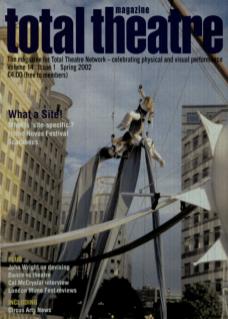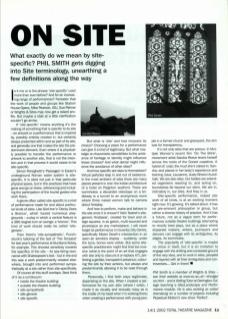Is it me or is the phrase 'site-specific' used more than ever before? And for an increasing range of performances? Fantastic that the work of people and groups like Station House Opera, Mike Pearson, IOU, Sue Palmer or Wrights & Sites may now get a raised profile. But maybe a stab at a little clarification wouldn't go amiss.
If 'site-specific' means anything it's the making of something that is specific to its site – an artwork or a performance that is inspired by, possibly entirely created in, but certainly always presented within and as part of its site, and generally one that makes the site the predominant element. Even where it is physically possible to transfer the performance or artwork to another site, that is not the intention and in that process it would cease to be site-specific.
Simon Persighetti's Passages in Exeter's underground Roman water system is site-specific. It is sited not just in that particular physical space, but in the practices that have gone and go on there, referencing and including the participation of the tourist guides who work there.
A genre often called site-specific is a kind of performance made for and about particular kinds of sites. Like Grid Iron's Decky Does a Bronco, which toured numerous playgrounds – a play in which a central feature is a 360-degree turn on swings: a 'bronco'. This kind of work should really be called 'site-generic'.
Then there's 'site-sympathetic'. Punchdrunk's tailoring of the text of The Tempest for last year's performance at Buckland Abbey, for example. This showed sensitivity towards the specifics of the site – its sea-faring resonance with Shakespeare's text – but in the end this was a work predominantly created elsewhere, brought into and performed sympathetically at a site rather than site-specifically.
Of course all this stuff overlaps. Best think of it as a continuum:
- Inside the theatre building
- outside the theatre building
- site-sympathetic
- site-generic
- site-specific
But what is 'site' and how innocent is its choice? Choosing a place for a performance can give it a kind of legitimacy. But what nostalgic or chauvinistic sensibilities to the ambience of heritage or identity might influence these choices? And what denial might influence the avoidance of other sites?
And how specific are sites to themselves? Virtual particles leap in and out of existence. In the most ambient of sites there are many places present in one: the Indian architecture of a hotel on Paignton seafront. There are wormholes: a discarded videotape on a bridleway is a tunnel to an anonymous room where three naked women talk to camera about foreplay.
And how to perform, make and behave in the site once it is chosen? Odin Teatret's site-generic Anabasis, created for town and village squares, is as garish, multi-sourced and picaresque as any marketplace. I will never forget its performance in Coventry City Centre, specifically Mister Death's intervention in an open-air aerobics display – suddenly, under the lycra, bones were visible. But some site-specific practitioners might find that too invasive (what is the point of an art that engages with site only to obscure it or replace it?), preferring a gentler, transparent presence; colouring the site by their actions, but always and predominantly allowing it to be read through them.
Personally, I find both ways legitimate, depending on the site. When I created a performance for my own attic (where I write), I made it as visually and textually noisy as is the inside of my head when I'm working there; when creating a performance with young people in a former church and graveyard, the aim was for transparency.
It's not only sites that are porous. In Multiple Women's recent film On The Brink, movement artist Sandra Reeve levers herself across the rocks of the Dorset coastline. A hybrid of: crab; the mud she's caked in; Sandra; and places in her body's experience and training (Java, Lausanne, dusty Bristol church hall). We are also sites. Our bodies are extended organisms reacting to, and acting on, boundaries far beyond our skins. We are in, intimately in, our sites. And they in us.
Site-specific performance, indeed site work of all kinds, is at an exciting moment right now. It's growing. It's talked about. It has no pre-eminent philosopher or group, but rather a diverse history of practice. And it has a future, not as a vague term for performances outside theatre buildings attempting to revivify tired plays, but as a place where disparate makers, writers, journeyers and dancers can engage with its ambiguities, its edges, its wormholes.
The popularity of 'site-specific' is maybe no virtue in itself, but it is an invitation to engage with the shifting and contested ground of the very idea, and to work in sites, peopled and layered with all their ambiguities and controversies... Get in there!
Phil Smith is a member of Wrights & Sites – see their website at www.ex.ac.uk-shodge/ws.html – and a Visiting Tutor at Dartington College teaching a Site/Landscape and Performance module. He is also working as writer/dramaturg on a number of projects including Perpetual Motion's new show Perfect.

